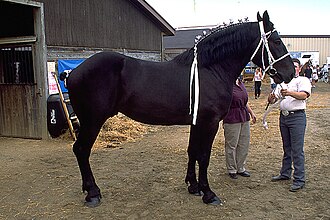(→Color) |
|||
| Line 38: | Line 38: | ||
==Color== | ==Color== | ||
| − | Percherons are generally [[black (horse)|black]] or [[Gray (horse)|gray] | + | Percherons are generally [[black (horse)|black]] or [[Gray (horse)|gray] But they also come in bay,roan and sorrel. Some registries only accept those two colors, though [[Chestnut (coat)chestnut]], [[Sorrel (horse)|sorrel]], and [[Bay (horse)|bay]] colors are acceptable for registration in the US with a [[Genetic fingerprinting|DNA test]] confirming their parentage. Gray and black are produced by [[dominant gene]]s. The red gene for chestnut is recessive, and a red foal can only result from the mating of two black horses if they are [[heterozygous]], having the red gene present in both sire and dam, and even then it is only a one in four chance that a chestnut will be produced. ''(See [[equine coat color genetics]])'' |
Some Percherons have white [[horse markings|markings]] on the head and feet, but excessive white is undesirable. | Some Percherons have white [[horse markings|markings]] on the head and feet, but excessive white is undesirable. | ||
Revision as of 16:05, 16 September 2007
The Percheron is a breed of powerful rugged draft horses that originated in the Perche valley in northern France.
History
Like many old breeds, the Percheron's exact origins are unknown, but it is said that its ancestors were crossbred between the heavy "forest horse" type of animal native to northern Europe and the Arabians that were brought to Europe by the Moors. Percherons probably owe their size and weight to their use as battle mounts during the Middle Ages. After the invention of gunpowder, heavy warhorses were no longer needed, so the Percheron took up its new job pulling heavy French stagecoaches. With the invention of the railroad, Percherons switched to farm duty and heavy labor.
It is probably because of this evolution that the modern Percheron is such a versatile and adaptable horse. Today, Percherons serve as logging horses but also are valued as pleasure driving horses, riding horses, and as competitors in both regular horse shows and in draft horse showing.
Conformation
Percherons are noted for heavy muscling and for an aspect of ruggedness and power. Also characteristic of the Percheron is clean action and quality conformation of the feet and legs. The mane is thick, though the tail is usually cut short. The breed is close coupled, wide and deep through the chest, with plenty of back rib. The muscles of the forearms, croup and gaskins are especially emphasized in a good drafter, and ease and balance of gait is essential. The horse is also expected to be of good temperament and be an easy keeper.
The Percheron head and neck is typical of the correct draft horse. Good Percherons have a large and full prominent eye, a broad and full forehead, and straight face. A wide jaw and refined ears attractively set and carried with animation are visible evidence of the Percheron's Arabian ancestry. Stallions should have a ruggedness about the head and mares should have a feminine look. The neck is well-shaped and powerful
Percherons have withers well defined, a short back, a deep girth, long, somewhat level croup, big, well-rounded hip, and powerful muscling in the lower thigh.
In recent years, modern show Percherons have been bred for a longer, thinner neck, a longer back, and longer, smoother-looking muscles. These types of modern percherons are used mainly as show horses for competition.
Temperament
The Percheron has a very pleasing disposition, and is proud, alert, and intelligent. They are generally very gentle horses, well-suited for driving, and are strong and willing workers. The Percheron is readily adapted to varying climates and conditions. They have the strength to pull heavy loads and the graceful style to pull a fine carriage. Percherons can be ridden and some have even been trained to jump.
Color
Percherons are generally black or [[Gray (horse)|gray] But they also come in bay,roan and sorrel. Some registries only accept those two colors, though Chestnut (coat)chestnut, sorrel, and bay colors are acceptable for registration in the US with a DNA test confirming their parentage. Gray and black are produced by dominant genes. The red gene for chestnut is recessive, and a red foal can only result from the mating of two black horses if they are heterozygous, having the red gene present in both sire and dam, and even then it is only a one in four chance that a chestnut will be produced. (See equine coat color genetics)
Some Percherons have white markings on the head and feet, but excessive white is undesirable.
Height and weight
Percherons range in height from 15 to 19 hands high, most are between 16-2 and 17-3 hands high. They can weigh up to 2,600 pounds with the average around 1,900. One of the tallest horses on record was a Percheron named Dr Le Gear. Foaled in 1902, he stood 21.1 hands (7 feet) at the withers and weighed just under 1,370 kg. However, there was once a Percheron on record that rose to a full 24 hands.
Lifespan
Percherons can be long-lived horses, living over 25 years. An unverified record states a Percheron lived to be 41.Template:Fact
External links
- Societe hippique Percheronne de France
- Percheron Horse Association of America
- Oklahoma State University's Percheron Page
- British Percheron Horse Society
be:Першэрон de:Percheron es:Percherón fr:Percheron ja:ペルシュロン pl:Perszeron fi:Perchenhevonen sv:Percheron

